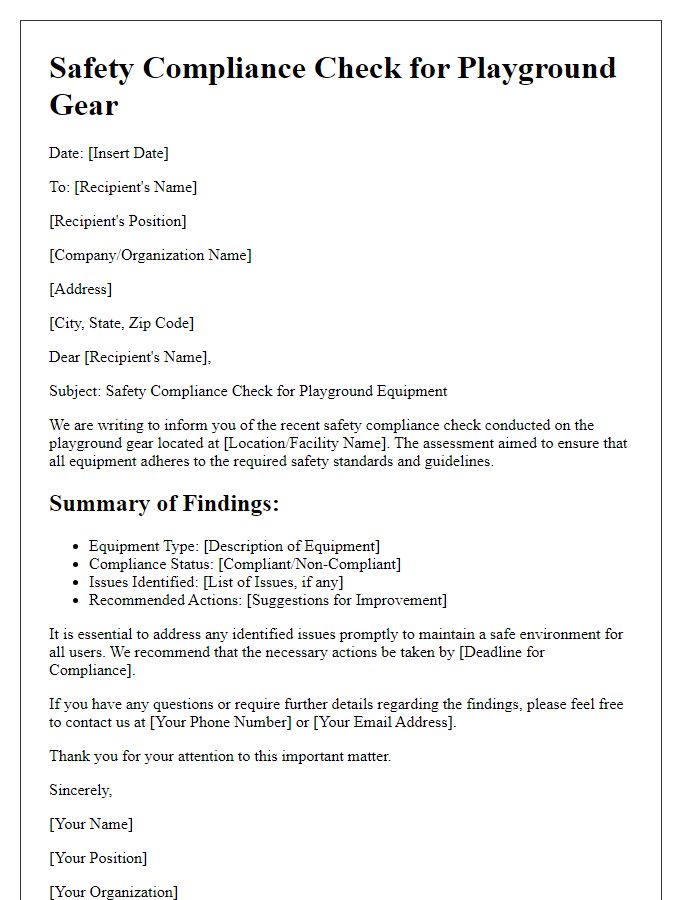Hey there! Ensuring your playground equipment is safe for children is crucial for their well-being and peace of mind for parents. In this article, we'll walk you through a comprehensive checklist to identify potential hazards and maintain the playground's integrity. From inspecting swings to checking safety mats, our guide will help you keep those joyful play areas secure. Dive in to learn more about how to keep playground fun and safe for everyone!

Equipment Structural Integrity
Conducting a playground equipment safety check involves rigorously assessing the structural integrity of various structures like swings, slides, climbing frames, and seesaws. Each piece, manufactured from materials such as steel or high-density polyethylene, must undergo inspections for signs of wear or deterioration, including rust, cracks, or loose bolts. The American Society for Testing and Materials (ASTM) provides guidelines recommending that equipment be evaluated at least once per year and after severe weather events, such as thunderstorms or snowstorms that may compromise stability. Playground surfaces, typically shock-absorbing materials like mulch or rubber mats, also need checking for depth consistency and proper installation, as these significantly reduce the risk of injuries from falls. Regular inspections ensure compliance with safety standards and promote a secure environment for children's play.
Surfacing and Fall Protection
Regular safety checks of playground equipment, especially those designed for children, are essential to ensure the surfacing and fall protection measures are effective. Impact-absorbing surfaces, such as rubber mulch and foam mats, are vital in reducing injury risks during falls. ASTM (American Society for Testing and Materials) guidelines recommend a minimum depth of 12 inches for loose-fill materials, while synthetic surfaces should be installed as per manufacturers' specifications to maintain their protective qualities. Inspecting for wear, displacement, or degradation in materials can help identify potential hazards. Additionally, compliance with standards set by organizations like CPSC (Consumer Product Safety Commission) can greatly enhance the safety measures in place, ensuring that the playground remains a secure environment for children to play and explore.
Bolts and Fastenings Security
Regular safety inspections of playground equipment are essential to ensure the safety of children at public parks and schools. One critical aspect of these inspections focuses on the security of bolts and fastenings, which play a vital role in maintaining structural integrity. Loose or rusted bolts on climbing structures, swings, and slides can lead to equipment failure, resulting in injuries. For instance, in a study by the U.S. Consumer Product Safety Commission, improper fastening was linked to 30% of playground-related accidents. Inspectors should check not only the tightness of each fastening but also the presence of galvanized or stainless steel materials to prevent corrosion. Additionally, every playground should be equipped with a checklist detailing specific items like the number of bolts, the condition of nuts and washers, and any signs of wear on attaching hardware. Regular maintenance schedules should be established to ensure ongoing inspections and prompt repairs wherever needed.
Visibility of Safety Signage
Proper visibility of safety signage is crucial for ensuring child safety in playground environments. Clear and prominently placed signs, such as those indicating age-specific usage restrictions or equipment guidelines, should be positioned at key entry points, like playground gates or near equipment areas. Bright colors (using contrasting hues like yellow and black for high visibility) and legible fonts (at least 1 inch high) enhance readability from a distance. Signage should also display critical safety information, including emergency contact numbers for local authorities and guidelines on proper usage to prevent injuries. Regular inspections (ideally conducted bi-annually) should verify that signs remain intact, unobstructed by foliage or debris, and that they reflect current safety regulations issued by organizations like the Consumer Product Safety Commission (CPSC).
Maintenance and Inspection Schedule
Regular maintenance and thorough inspections of playground equipment ensure children's safety during recreational activities. Equipment such as swings, slides, and climbing structures must undergo inspections every six months to identify wear and tear, particularly in high-traffic areas. Components including bolts, chains, and safety surfacing should be examined meticulously for any signs of damage or deterioration. The American Society for Testing and Materials (ASTM) guidelines recommend that inspections assess equipment under different weather conditions, including rain and extreme heat, to gauge material performance. Documentation of each inspection, including specific dates, conditions observed, and actions taken, is crucial for maintaining compliance and promoting a safe play environment.













Comments